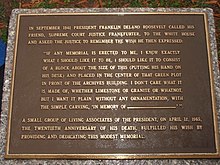Franklin Delano Roosevelt Memorial
Dedicated on May 2, 1997, by President Bill Clinton, the national memorial, spread over 7.5 acres (3.0 ha) adjacent to the southwest side of the Tidal Basin along the Cherry Tree Walk in West Potomac Park, traces 12 years of the history of the United States through a sequence of four outdoor rooms, one for each of FDR's terms of office.
A bronze statue of First Lady Eleanor Roosevelt standing before the United Nations emblem honors her work with the UN and the Universal Declaration of Human Rights.
[5] The national memorial now includes sculptures and works by Leonard Baskin, Neil Estern, Robert Graham, Tom Hardy, and George Segal.
Tour guides describe the symbolism of the five main water areas as: The architecture critic of the Washington Post stated that the memorial was designed "to give people as many options as possible to go this way or that, to reverse directions, to pause, to start over, to be alone, to meet others, and to experience as many different sights, smells and sounds as the site permits.
However, within a matter of days, the National Park Service (NPS), which operates the Memorial, prohibited people from entering the water due to fear of accidents.
[citation needed] The National Organization on Disability, headed by the efforts of Alan Reich, raised US$1.65 million over two years to fund the addition of another statue that clearly showed the president in a wheelchair.
"[4] During a conversation that he had with Supreme Court Associate Justice Felix Frankfurter in 1941, Roosevelt said that if he were to have a monument in Washington, it should be in front of the National Archives and should be no larger than his desk.
I should like it to consist of a block about the size of this (putting his hand on his desk) and placed in the center of that green plot in front of the Archives Building.
A small group of living associates of the President, on April 12, 1965, the twentieth anniversary of his death, fulfilled his wish by providing and dedicating this modest memorial.


